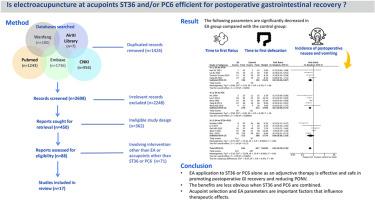Electroacupuncture of ST36 and PC6 for postoperative gastrointestinal recovery: A systematic review and meta-analysis
IF 3
3区 医学
Q1 INTEGRATIVE & COMPLEMENTARY MEDICINE
Journal of Traditional and Complementary Medicine
Pub Date : 2024-03-22
DOI:10.1016/j.jtcme.2024.03.014
引用次数: 0
Abstract
Objective
This study was designed to determine the efficacy and safety of electroacupuncture (EA) at acupoints ST36 and/or PC6 for postoperative gastrointestinal (GI) recovery.
Method
Studies were retrieved from the PubMed, EMBASE, China National Knowledge Infrastructure (CNKI), Wanfang, and Airiti library databases from inception to January 23, 2024. Randomized controlled trials (RCTs) that evaluated the effect of EA at ST36 and/or PC6 on postoperative GI recovery were reviewed. Studies that involved acupoints other than the two or treatment modalities other than EA were excluded.
Results
Meta-analysis of 17 RCTs revealed that the time to first flatus (Mean difference (MD) = −5.06 h; 95% Confidence interval (CI), −7.12 to −3.01) and time to first defecation (MD = −12.29 h; 95% CI, −20.64 to −5.21) were significantly shorter in the EA group compared with the control group. The incidence of post-operative nausea and vomiting (PONV) was also significantly lower in the EA group than in the control group (Risk ratio (RR) = 0.62; 95% CI, 0.49–0.78).
Conclusion
EA application to ST36 or PC6 alone as an adjunctive therapy is effective and safe in promoting postoperative GI recovery and reducing PONV. The benefits are less obvious when ST36 and PC6 are combined. Acupoint selection and EA parameters are important factors that influence therapeutic effects. The establishment of a standardized EA protocol is imperative to minimize bias in research and to maximize applicability in clinical practice.

电针 ST36 和 PC6 促进术后胃肠道恢复:系统回顾和荟萃分析
方法从 PubMed、EMBASE、中国国家知识基础设施(CNKI)、万方和 Airiti 图书馆数据库中检索从开始到 2024 年 1 月 23 日的研究。回顾了评估 ST36 和/或 PC6 穴位 EA 对术后消化道恢复影响的随机对照试验(RCT)。结果对 17 项随机对照试验进行的元分析表明,与对照组相比,EA 组首次排便时间(平均差 (MD) = -5.06 h;95% 置信区间 (CI),-7.12 至 -3.01)和首次排便时间(平均差 (MD) = -12.29 h;95% 置信区间 (CI),-20.64 至 -5.21)明显缩短。EA组术后恶心和呕吐(PONV)的发生率也明显低于对照组(风险比(RR)= 0.62;95% CI,0.49-0.78)。当 ST36 和 PC6 结合使用时,疗效就不那么明显了。穴位选择和 EA 参数是影响治疗效果的重要因素。必须建立标准化的 EA 方案,以最大限度地减少研究中的偏差,并最大限度地提高临床实践中的适用性。
本文章由计算机程序翻译,如有差异,请以英文原文为准。
求助全文
约1分钟内获得全文
求助全文
来源期刊

Journal of Traditional and Complementary Medicine
Medicine-Complementary and Alternative Medicine
CiteScore
9.30
自引率
6.70%
发文量
78
审稿时长
66 days
期刊介绍:
eJTCM is committed to publish research providing the biological and clinical grounds for using Traditional and Complementary Medical treatments as well as studies that demonstrate the pathophysiological and molecular/biochemical bases supporting the effectiveness of such treatments. Review articles are by invitation only.
eJTCM is receiving an increasing amount of submission, and we need to adopt more stringent criteria to select the articles that can be considered for peer review. Note that eJTCM is striving to increase the quality and medical relevance of the publications.
 求助内容:
求助内容: 应助结果提醒方式:
应助结果提醒方式:


